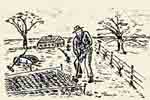

 |
 |
| Home | Index | Museums | Blog | Authors | Site Map | About |
|
1822New York City / State Timelinefrom Eagles Byte by David MinorYear-by-year tracing the growth of the early days of the RepublicNew York City was really becoming quite an urbane sort of place in 1822 with for example, a growing number of water connections with the outside world. Even Hoboken. A ferry of that name was begun, advertised to make the round trip to New Jersey every two hours. Regular service by coastal vessels was established to Charleston, North Carolina. Long Island packet boats could get you to Boston in just 25 yours. If your travel plans included the Continent, a line of packets leaving every other month could whisk you to La Havre, France. Not that ship travel was always that safe. Enough vessels were lost this year so that the U. S. inventors began working on the problem. Enter "Moccasin" Jackson, a local eccentric who owned a shop on Pearl Street where he sold beds and bedding. Not surprisingly, his effort in designing some sort of "life preserver" turned out to look quite a bit like a mattress. Not a huge success, it seems. But our leather-footed entrepreneur had other irons in the fire. He was one of those early Yankee Doodle Dandies who took race horses to Europe. If you couldn't afford the time or money to travel to Europe, with or without a horse, you could always keep fairly up-to-date with the former Mother Country by reading Dr. J. S. Bartlett's new publication The Albion, which devoted its pages to British news. New York was also becoming more and more of a theatre town. The Chatham Garden, near today's Foley Square, opened in June as a saloon with a small "concert" stage, but within a year it would upgrade to a full-scale theatre. In July the City Theatre opened nearby on Broadway. If a play or concert wasn't to your taste there were always the outdoor public gathering places such as Tammany Hall and Richmond Hill Garden. For pleasure on a more lofty plane you could always go to a talk at the American Bible Society. If you were there on May 9th, you were treated to an address by the society president, former U. S. diplomat and state governor John Jay, who discussed the inadequacy of reason to penetrate the mystery of God. There was another mystery as yet unpenetrated, one that made an appearance here every few years. On June 17th a case of yellow fever broke out on Lumber Street, near the Battery. As the situation began rapidly deteriorating, the city declared anything below City Hall an infested district and put up a barricade along Chambers Street. Lower Manhattan became deserted as people fled northward to anywhere the air was considered more wholesome. One of the favorite destinations was a village part way up Manhattan Island called Greenwich. It's population exploded. The various ferries, including the new Hoboken one, changed their New York moorings to Greenwich. A boarding house for 300 people popped up where corn had been growing two days previously. Where Chelsea's McBirney YMCA now stands, a whole neighborhood sprouted, where Scotch weavers began plying their trade, the area quickly being dubbed Paisley Place. Before autumn ended the epidemic, 388 New Yorkers had died. By October things returned almost to normal except for those who decided to stay in Greenwich and settle. Yellow Fever remained a mystery on into the next century. New Yorkers remained almost clueless. Churchyard burials did become suspect, and were banned. However the use of free-range hogs to eat the garbage in the streets would continue unabated for another three years.
New York State's new constitution, calling for gubernatorial elections every two years, went into effect in 1822. It was good news for DeWitt Clinton, the former governor, voted out of office last year. Meant he'd only have to wait half as long before being voted back in. The state saw other innovations and changes this year. Chemung, Niagara and Orleans counties got their first printing presses. The two-year-old Shaker colony at Watervliet got a Brethren's Shop and Sisters' Workshop; Episcopal bishop John Henry Hobart's college got Geneva Hall, the nucleus of his Geneva campus; Charlotte got a lighthouse. Bath hosted the first Steuben County Agricultural Society fair, with a race track and livestock competitions featuring nine categories for the judging of cattle and sheep. And Rochesterville, now with a population of 2,700, plus 430 laboring on public works, got its first court house. New name, too. On April 12th the village name was officially shortened to Rochester. It's not too surprising that one of the first things village trustees in an up-and-coming frontier town did, was to levy an annual license fee on gambling dens. But there were "good" works around as well; the Female Charitable Society was organized, at the home of almanac publisher Everard Peck, to visit the poor and the sick. Their efforts would one day lead to the founding of Rochester General Hospital. Other early modest conferences at the Peck home would lead to the founding of the University of Rochester. Peck helped found a career as well this year, giving a job to a young printer and would be politician who walked in off the street one day, by the name of Thurlow Weed. Geologist Amos Easton, who always kept his publishers and printers busy, published "A Geological Profile of the Rocks from Onondaga Salt Springs, N. Y. To Williams College, Mass." Another publisher we've met before, Horatio Gates Spafford had a habit of getting sidetracked every now and then, especially with inventing. On October 30th he was granted two patents on a steel manufacturing process, similar to and anticipating the Bessemer method that would not come along for another 34 years. Seeking offers from the U. S. Government as well as the Emperor of Russia, he was still fearful of patent infringement, so failed to describe the process in detail. Thus leaving us with a bit of an unsolvable metallurgical mystery. While Horatio and his inventions waited at the bridge to fame that autumn, things were proceeding rapidly on that greater technical undertaking, the Erie Canal. With planners creating a school of American engineering as they went along, construction projects all across the state in November raced the winter hiatus. Aqueducts had already been completed at Schoharie, Little Falls and Rochester, both paling in comparison with the mile-long Grand Embankment, which carried the canal 70 feet above Monroe County's Irondequoit Valley. Canal traffic was now moving the 200 miles from Rochester to Utica and a short time later the canal was extended to Schenectady. Work at both ends of the system would not be completed for another three years. The building of the Rochester Aqueduct brought many workers to the village on the Genesee. One was fated to have a profound influence on the political history of the state-a young mason (capital and small "M") by the name of William Morgan. Buffalo judge Samuel Wilkeson, as much as anyone, can be considered the reason why we don't sing "Shuffle Off to Black Rock." Before we leave 1822 New York for other climes and times we should pay a second visit to the judge. We first met him in 1820, when he was instrumental in having a pier built at Buffalo that resisted two storm-tossed vessels that slammed into it. But Judge Wilkeson, good booster that he was, wanted more than just a pier for his adopted town. He wanted a canal. Born in Carlisle, Pennsylvania, in 1781, he spent his first 25 years working on a farm. But a vast body of water far to the northwest captured his imagination. Around the year 1806 he resettled on Lake Erie and began building boats, successfully engaging in trade. During the war of 1812 his vessels transported the troops of William Henry Harrison when the general invaded Canada. As the war ran down Wilkeson settled in Buffalo, concentrating on his mercantile efforts. A man with many irons in the fire! But it was his efforts to bring the Erie Canal to Buffalo that really set him apart. Once it was determined the final route would push west to connect up with the Niagara River or Lake Erie (advisers to gubernatorial candidate Daniel Tompkins advised him to end it at Tonawanda), Wilkeson stepped up the pace of harbor improvements. Then in November of last year the early western Lakes steamboat Walk-in-the-Water, ran aground after setting out from Buffalo then quickly returning in the teeth of a lake storm that had blown up out of the west. Soon afterwards a representative from the company that built the steamboat came out to assess the damage. He made some rash remarks about the Buffalo harbor within earshot of the judge; even used the "h" word. "Humbug" that is, not the one you're thinking of. He'd pushed the right button. The company wanted to build the Superior, a replacement boat and Judge Wilkeson told him he could get the grounded boat out of the company's way by May 1, 1822, a little less than seven months away. But Buffalo would have to cough up $150 for every day past that date the boat was still trapped. Not to keep you in suspense, the judge put crews on the job, paid overtime and got the vessel refloated and back over the sand bar on April 13th. No mention of a rebate from the company for the extra 17 days, of course. But Wilkeson had built his harbor and made it work. In later years he would go on to become mayor of Buffalo, state senator, builder of the first iron-foundry in Buffalo, and president of the American Colonization Society, promoting commercial relations between Baltimore and Philadelphia and the new African nation of Liberia. The Walk-in-the-Water had ended its brief career. But one of the engine cylinders would end up in Buffalo's Shepherd & Company steam-engine works, still operating in 1865. Black Rock hadn't given up yet. But, despite a state grant of $12,000 this year for harbor improvements of its own, and a later $8,000 grant, her efforts were doomed. In the winter of 1824-1825 wind and ice did severe damage to the improvements. And, it was pointed out, that because of the rapids of the Niagara, ox teams would be required to pull boats up the river. And also that Buffalo was much higher above sea level and could more easily keep the canal filled from the waters of the lake. In 1853 Buffalo annexed Black Rock. © 2002, David Minor
The Eagles Byte New York City / State Timeline is from David Minor's radio scripts for Simon Pontin's Salmagundy radio program on WXXI-FM (91.5). David can be heard every Saturday morning at 10:15 talking about various aspects of world history. CLR Blog | Site Map | Contact CLR |